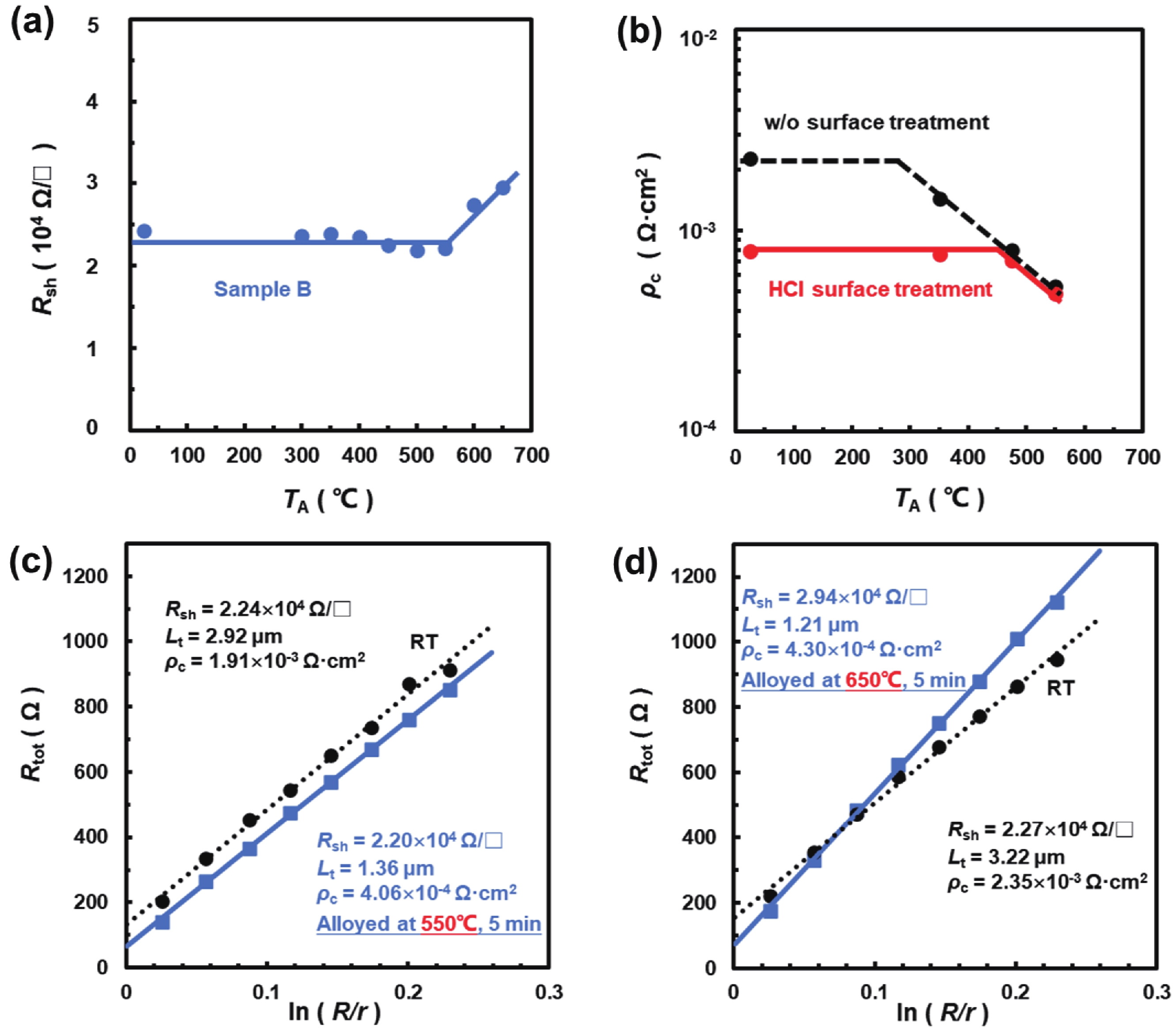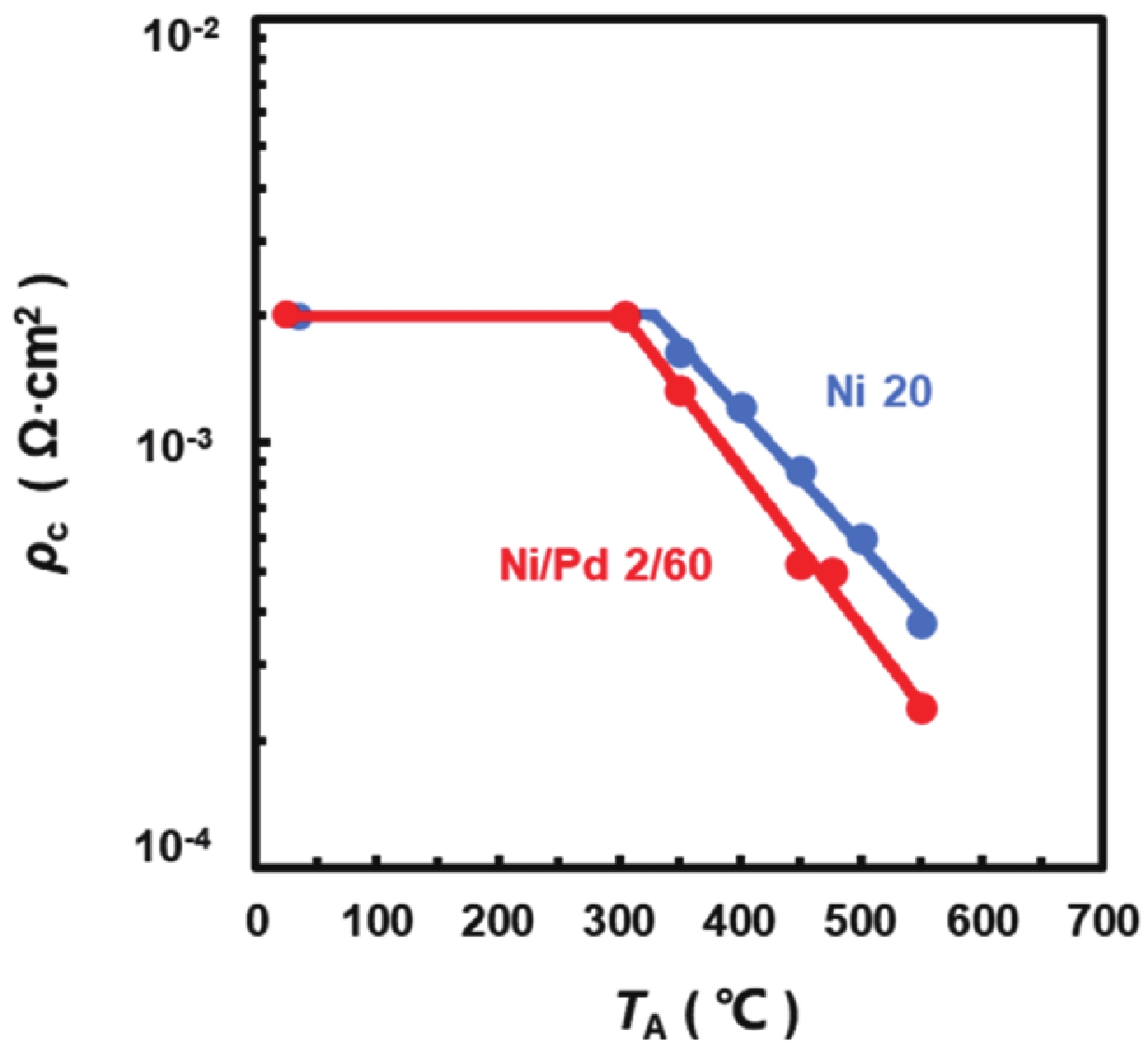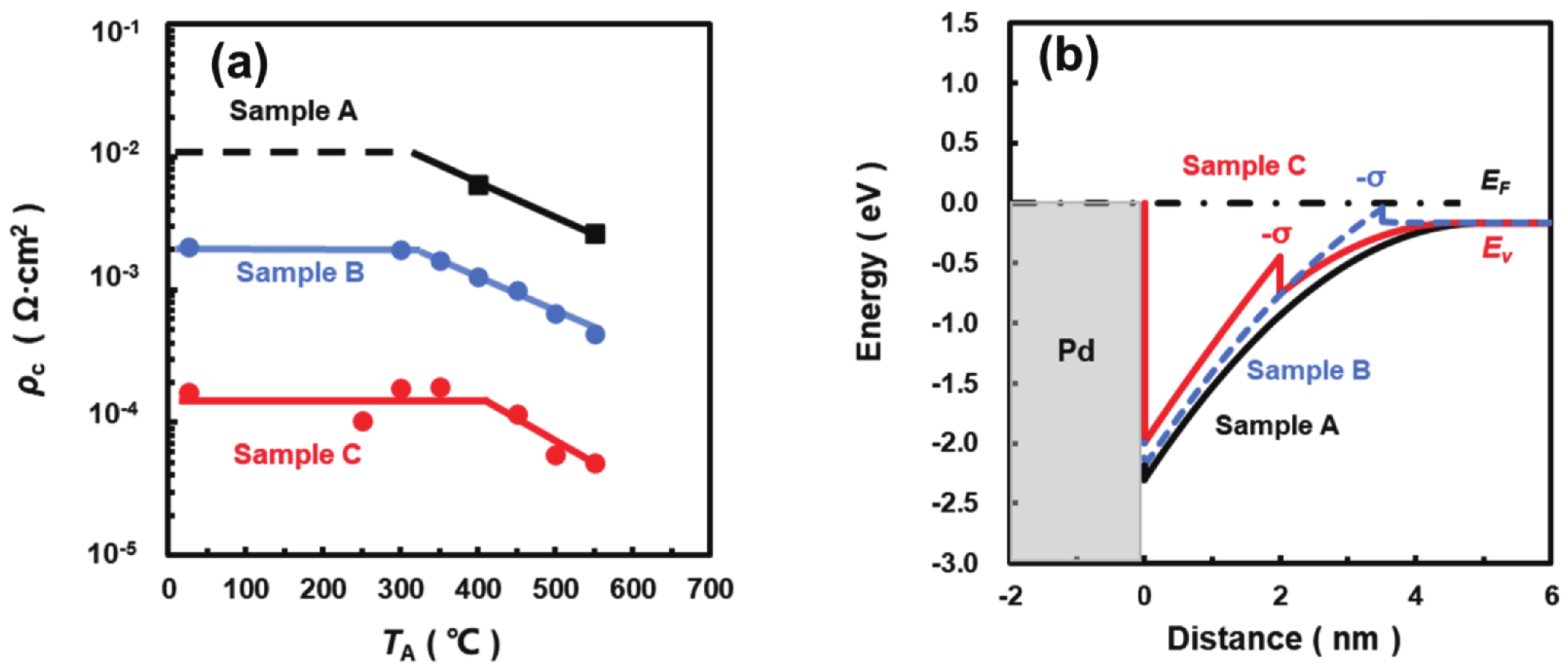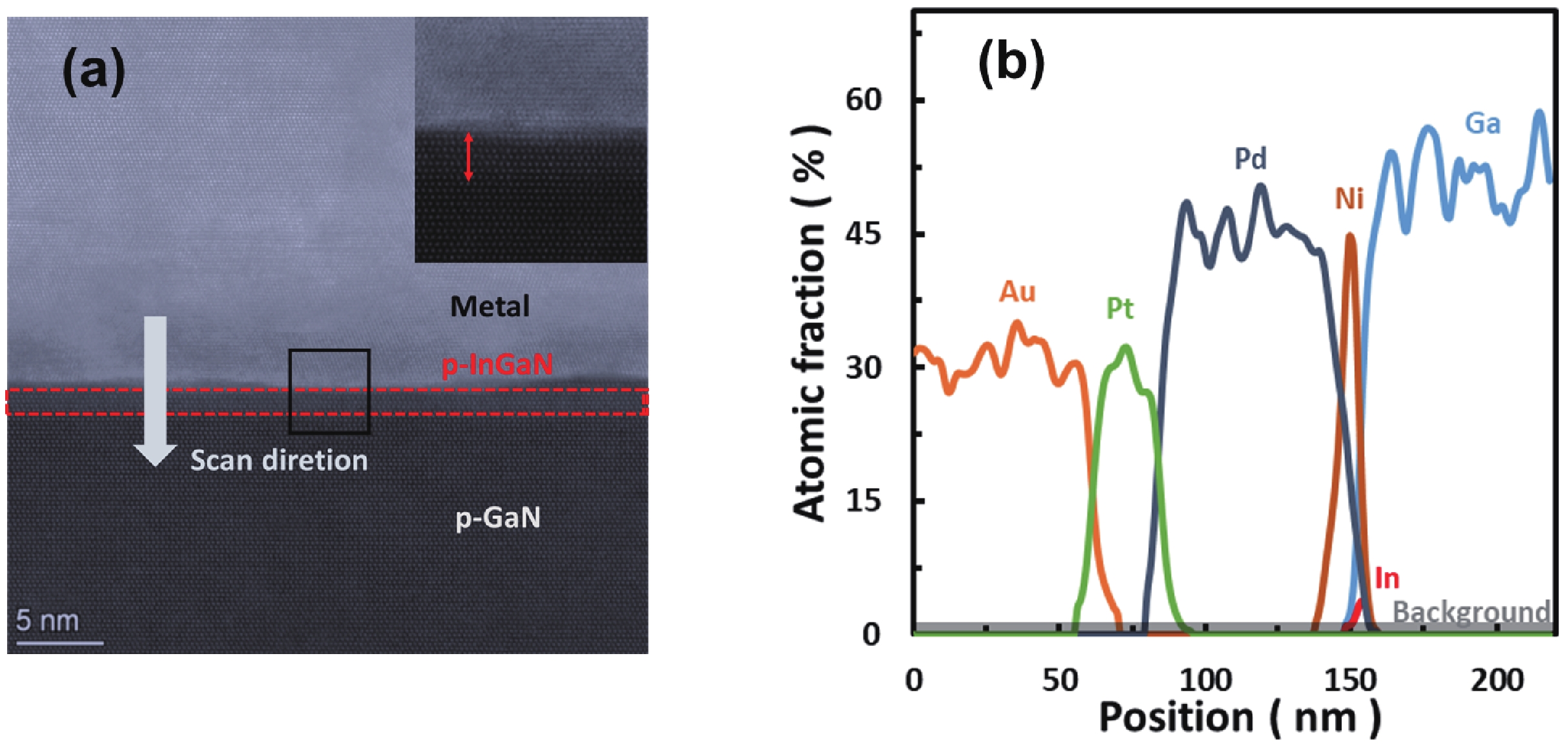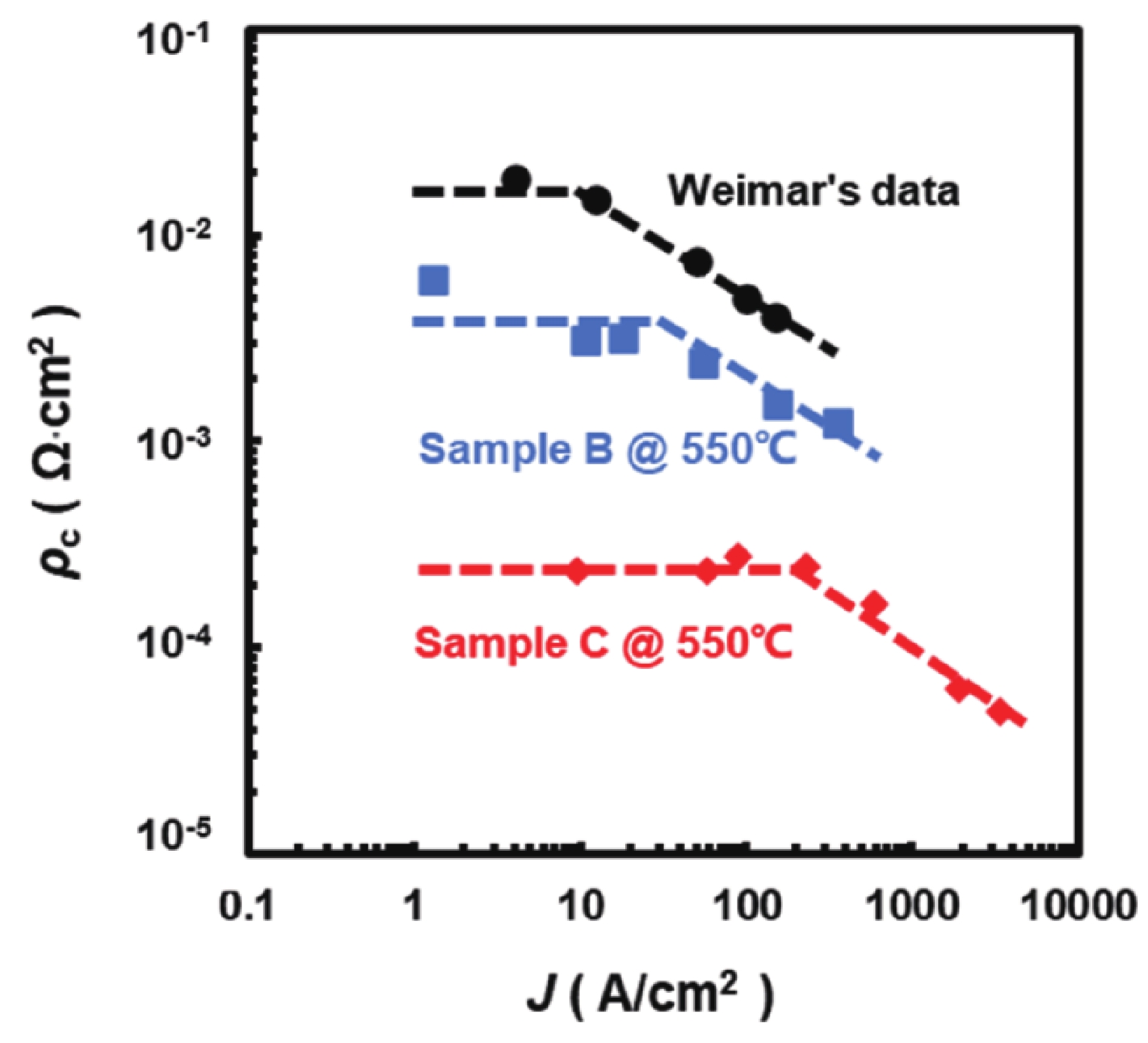| Citation: |
Minglong Zhang, Masao Ikeda, Siyi Huang, Jianping Liu, Jianjun Zhu, Shuming Zhang, Hui Yang. Ni/Pd-based ohmic contacts to p-GaN through p-InGaN/p+-GaN contacting layers[J]. Journal of Semiconductors, 2022, 43(9): 092803. doi: 10.1088/1674-4926/43/9/092803
****
M L Zhang, M Ikeda, S Y Huang, J P Liu, J J Zhu, S M Zhang, H Yang. Ni/Pd-based ohmic contacts to p-GaN through p-InGaN/p+-GaN contacting layers[J]. J. Semicond, 2022, 43(9): 092803. doi: 10.1088/1674-4926/43/9/092803
|
Ni/Pd-based ohmic contacts to p-GaN through p-InGaN/p+-GaN contacting layers
DOI: 10.1088/1674-4926/43/9/092803
More Information
-
Abstract
Specific contact resistance$ {\rho }_{\mathrm{c}} $ to p-GaN was measured for various structures of Ni/Pd-based metals and thin (20–30 nm thick) p-InGaN/p+-GaN contacting layers. The effects of surface chemical treatment and annealing temperature were examined. The optimal annealing temperature was determined to be 550 °C, above which the sheet resistance of the samples degraded considerably, suggesting that undesirable alloying had occurred. Pd-containing metal showed ~35% lower$ {\rho }_{\mathrm{c}} $ compared to that of single Ni. Very thin (2–3.5 nm thick) p-InGaN contacting layers grown on 20–25 nm thick p+-GaN layers exhibited one to two orders of magnitude smaller values of$ {\rho }_{\mathrm{c}} $ compared to that of p+-GaN without p-InGaN. The current density dependence of$ {\rho }_{\mathrm{c}} $ , which is indicative of nonlinearity in current-voltage relation, was also examined. The lowest$ {\rho }_{\mathrm{c}} $ achieved through this study was 4.9 × 10–5 Ω·cm2 @ J = 3.4 kA/cm2.-
Keywords:
- GaN,
- ohmic contact,
- specific contact resistance
-
References
[1] Nakamura S. The roles of structural imperfections in InGaN-based blue light-emitting diodes and laser diodes. Science, 1998, 281, 956 doi: 10.1126/science.281.5379.956[2] Hu L, Ren X Y, Liu J P, et al. High-power hybrid GaN-based green laser diodes with ITO cladding layer. Photonics Res, 2020, 8, 279 doi: 10.1364/PRJ.381262[3] Li L, Nomoto K, Pan M, et al. GaN HEMTs on Si with regrown contacts and cutoff/maximum oscillation frequencies of 250/204 GHz. IEEE Electron Device Lett, 2020, 41, 689 doi: 10.1109/LED.2020.2984727[4] Koide Y, Maeda T, Kawakami T, et al. Effects of annealing in an oxygen ambient on electrical properties of ohmic contacts to p-type GaN. J Electron Mater, 1999, 28, 341 doi: 10.1007/s11664-999-0037-7[5] Luther B P, Mohney S E, Jackson T N, et al. Investigation of the mechanism for Ohmic contact formation in Al and Ti/Al contacts to n-type GaN. Appl Phys Lett, 1997, 70, 57 doi: 10.1063/1.119305[6] Singh K, Chauhan A, Mathew M, et al. Formation of non-alloyed Ti/Al/Ni/Au low-resistance ohmic contacts on reactively ion-etched n-type GaN by surface treatment for GaN light-emitting diodes applications. Appl Phys A, 2019, 125, 24 doi: 10.1007/s00339-018-2322-x[7] Tanaka T, Watanabe A, Amano H, et al. P-type conduction in Mg-doped GaN and Al0.08Ga0.92N grown by metalorganic vapor phase epitaxy. Appl Phys Lett, 1994, 65, 593 doi: 10.1063/1.112309[8] Ho J K, Jong C S, Chiu C C, et al. Low-resistance ohmic contacts to p-type GaN. Appl Phys Lett, 1999, 74, 1275 doi: 10.1063/1.123546[9] Kim J K, Lee J L, Lee J W, et al. Low resistance Pd/Au ohmic contacts to p-type GaN using surface treatment. Appl Phys Lett, 1998, 73, 2953 doi: 10.1063/1.122641[10] Wahid S, Chowdhury N, Alam M K, et al. Barrier heights and Fermi level pinning in metal contacts on p-type GaN. Appl Phys Lett, 2020, 116, 213506 doi: 10.1063/5.0010699[11] Wang W J, Xie W Z, Deng Z J, et al. Performance improvement of GaN based laser diode using Pd/Ni/Au metallization ohmic contact. Coatings, 2019, 9, 291 doi: 10.3390/coatings9050291[12] Chary I, Chandolu A, Borisov B, et al. Influence of surface treatment and annealing temperature. J Electron Mater, 2009, 38, 545 doi: 10.1007/s11664-008-0655-5[13] Mallem S P R, Ahn W H, Lee J H, et al. Influence of thermal annealing on the PdAl/Au metal stack ohmic contacts to p-AlGaN. Crystals, 2020, 10, 1091 doi: 10.3390/cryst10121091[14] Lee J L, Weber M, Kim J K, et al. Ohmic contact formation mechanism of nonalloyed Pd contacts to p-type GaN observed by positron annihilation spectroscopy. Appl Phys Lett, 1999, 74, 2289 doi: 10.1063/1.123827[15] Song J O, Leem D S, Kwak J S, et al. High-quality nonalloyed rhodium-based ohmic contacts to p-type GaN. Appl Phys Lett, 2003, 83, 2372 doi: 10.1063/1.1613991[16] He J L, Zhong Y Z, Zhou Y, et al. Recovery of p-GaN surface damage induced by dry etching for the formation of p-type Ohmic contact. Appl Phys Express, 2019, 12, 055507 doi: 10.7567/1882-0786/ab13d7[17] Kumakura K, Makimoto T, Kobayashi N. Ohmic contact to p-GaN using a strained InGaN contact layer and its thermal stability. Jpn J Appl Phys, 2003, 42, 2254 doi: 10.1143/JJAP.42.2254[18] Trexler J T, Pearton S J, Holloway P H, et al. Comparison of Ni/Au, Pd/Au, and Cr/Au metallizations for ohmic contacts to p-GaN. MRS Online Proc Libr, 1996, 449, 1091 doi: 10.1557/PROC-449-1091[19] Bernardini F, Fiorentini V. Spontaneous versus piezoelectric polarization in III-V nitrides: Conceptual aspects and practical consequences. Phys Status Solidi B, 1999, 216, 391 doi: 10.1002/(SICI)1521-3951(199911)216:1<391::AID-PSSB391>3.0.CO;2-K[20] Weimar A, Lell A, Brüderl G, et al. Investigation of low-resistance metal contacts on p-type GaN using the linear and circular transmission line method. Phys Status Solidi A, 2001, 183, 169 doi: 10.1002/1521-396X(200101)183:1<169::AID-PSSA169>3.0.CO;2-D -
Proportional views







 DownLoad:
DownLoad:
